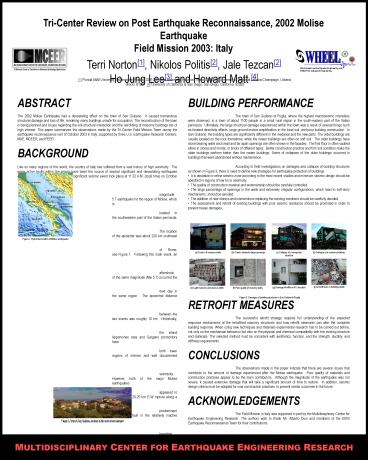Tri-Center Review on Post Earthquake Reconnaissance, 2002 Molise Earthquake - PowerPoint PPT Presentation
1 / 1
Title:
Tri-Center Review on Post Earthquake Reconnaissance, 2002 Molise Earthquake
Description:
The 2002 Molise Earthquake had a devastating effect on the town of San Giuliano. ... In San Giuliano, the building types are significantly different in the medieval ... – PowerPoint PPT presentation
Number of Views:25
Avg rating:3.0/5.0
Title: Tri-Center Review on Post Earthquake Reconnaissance, 2002 Molise Earthquake
1
Tri-Center Review on Post Earthquake
Reconnaissance, 2002 Molise Earthquake Field
Mission 2003 Italy
Terri Norton1, Nikolos Politis2, Jale
Tezcan2 Ho Jung Lee3 and Howard Matt 4
1 Florida AM University, Tallahassee, Florida
32310 2 Rice University, Houston, Texas 77005
3 University of Illinois at Urbana-Champaign,
Urbana, Illinois 61801 4 University of
California at San Diego, San Diego, California
92093
- ABSTRACT
- The 2002 Molise Earthquake had a devastating
effect on the town of San Giuliano. It caused
tremendous structural damage and loss of life,
rendering many buildings unsafe for occupation.
The reconstruction of the town is being planned
and issues regarding the soil-structure
interaction and the retrofitting of masonry
buildings are of high interest. This paper
summarizes the observations made by the
Tri-Center Field Mission Team during the
earthquake reconnaissance visit of October 2003
in Italy, supported by three U.S. Earthquake
Research Centers MAE, MCEER, and PEER. - BACKGROUND
- Like so many regions of this world, the country
of Italy has suffered from a vast history of high
seismicity. The many active faults within the
region have been the source of several
significant and devastating earthquake events
(News 2003). The most recent significant seismic
event took place at 1132 A.M. (local time) on
October 31, 2002. The moment - magnitude 5.7 earthquake hit the region of
Molise, which is located in the southeastern
part of the Italian peninsula. The location
of the epicenter was about 220 km southeast of
Rome, see Figure 1. Following this main event,
an aftershock of the same magnitude (Mw 5.7)
occurred the next day in the same region. The
epicentral distance between the two events
was roughly 10 km. Historically, the inland
Appennines area and Gargano promontory have
both been regions of intense and well
documented seismicity. However, both of the
major Molise earthquakes appeared to result
from a 20-25 km E-W rupture along a
predominantly strike-slip fault in the
relatively inactive transition zone between
the Appennines and Gargano promontory. - Due to the low seismicity of the region, seismic
recording stations in the epicentral area were
few and far between. The closest seismic
recording station was about 27km southwest of the
epicenter. At this station, the peak ground
acceleration recorded from the main event was
about .02g while the largest recorded PGA was
about .07g at the Lesina Station, roughly 40km
northeast of the epicenter. Despite the
relatively small ground motions recorded from the
main shock, the earthquake was felt over a very
large area and resulted in fairly widespread
damage to 50 villages. A total of 30 people
were killed, 27 of who were children caught
within a collapsed school in town of San Giuliano
(Dusi 2003) (Team 2003). - The 2002 Molise earthquake has ignited interest
by people worldwide. As with any tragic seismic
event, much consideration and time has been
invested in an attempt to understand the causes
of damage as well as identify necessary
structural changes required such that future
disaster can be prevented. On October 17, 2003 a
small group of students representing the three
U.S. earthquake engineering research
organizations visited the town of San Giuliano to
survey the damage experienced by the 2002 Molise
earthquake. - OBJECTIVES
- To assess the social impact and structural
damage inflicted by this earthquake - Understand and compare the differences in
building construction, local design codes, and
retrofit techniques utilized in Italy - BUILDING SUMMARY
- BUILDING PERFORMANCE
- The town of San Giuliano di Puglia, where the
highest macroseismic intensities were observed,
is a town of about 1100 people in a small rural
region in the south-eastern part of the Italian
peninsula. Ultimately, the large structural
damage experienced within the town was a result
of several things such as forward directivity
effects, large ground motion amplification in the
local soil, and poor building construction. In
San Giuliano, the building types are
significantly different in the medieval and the
new parts. The older buildings are usually
located on the rock formations, while the newer
buildings are often on soft soil. The older
buildings have stone bearing walls and small and
far apart openings are often shown in the
facades. The first floor is often vaulted either
in stones and mortar, or bricks of different
types. Better construction practice and firm
soil condition make the older buildings perform
better than the newer buildings. Some of
collapses of the older buildings occurred in
buildings that were abandoned without
maintenance. - According to field investigations on damages and
collapse of building structures as shown in
Figure 3, there is need to define new strategies
for earthquake protection of buildings. - It is desirable to refine seismic zone
according to the most recent studies and minimum
seismic design should be specified in regions of
low to no seismicity. - The quality of construction material and
workmanship should be carefully controlled. - The large percentage of openings in the walls
and extremely irregular configurations, which
lead to soft-story mechanisms, should be avoided. - The addition of new storeys and interventions
replacing the existing members should be
carefully decided. - The assessment and retrofit of existing
buildings with poor seismic resistance should be
promoted in order to prevent heavy damages.
Figure 1. Epicentral location of Molise
earthquake
Figure 3. Damages of building structures in San
Giulano di Puglia































